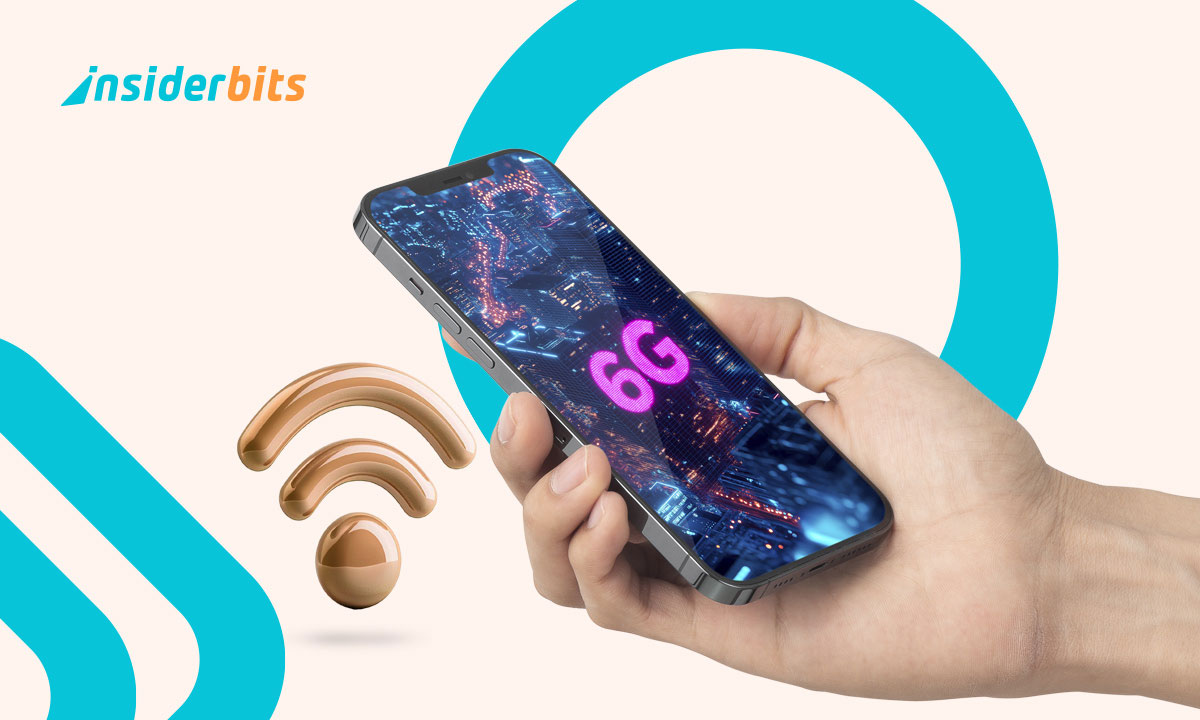The next generation of wireless technology—6G—is already in development, promising to revolutionize connectivity beyond what 5G currently offers.
While 5G brought faster speeds and lower latency, 6G aims to transform the internet into a seamless, intelligent network capable of supporting advanced AI, immersive realities, and real-time global connectivity.
This article explores what makes 6G different, its potential applications, and when we can expect it to become a reality.
- 5 meilleures applications pour vérifier votre connexion Internet
- Comment regarder TikTok sans Internet
- How to Get Free Internet 2025 Guide
5G vs. 6G: What’s Really Different?
While 5G represented a major advancement over 4G networks, 6G is poised to fundamentally redefine wireless connectivity through several groundbreaking innovations.
The differences between these generations extend far beyond simple speed improvements, encompassing entirely new approaches to network architecture, intelligence, and global coverage.
Revolutionary Speed and Near-Zero Latency
The most immediately noticeable difference will be in raw performance metrics:
5G Networks Today:
- Maximum theoretical speeds: 10 Gbps (practical speeds typically 100-900 Mbps);
- Latency: 1-5 milliseconds in optimal conditions;
- Bandwidth: Supports about 1 million devices per square kilometer.
6G Projections:
- Theoretical peak speeds reaching 1 Terabit per second (1,000 Gbps);
- Latency reduced to 0.1 milliseconds – faster than human neural response times;
- Capacity for 10 million connected devices per square kilometer.
This quantum leap in performance, as documented in TechTarget’s 6G analysis, will enable previously impossible applications like:
- Real-time holographic telepresence with tactile feedback;
- Direct brain-computer interfaces for immersive experiences;
- Instantaneous large-scale data transfers (entire movies in milliseconds).
From Cloud-Centric to Distributed AI Networks
The architectural philosophy undergoes a radical transformation:
5G Architecture:
- Primarily relies on centralized cloud data centers;
- Limited edge computing capabilities;
- Static network configurations requiring manual optimization.
6G Innovations:
- AI-native design with machine learning at every network layer;
- Self-optimizing networks that predict and prevent congestion;
- Distributed edge intelligence bringing processing closer to end-users.
A TechRepublic report explains how 6G networks will employ predictive algorithms to:
- Anticipate user demand patterns before requests are made;
- Dynamically allocate resources based on real-time needs;
- Self-heal from disruptions without human intervention.
Global Ubiquitous Coverage
The reach of wireless connectivity expands dramatically:
5G Limitations:
- Dependent on terrestrial cell towers;
- Significant coverage gaps in rural/remote areas;
- Limited maritime and aerial connectivity.
6G Solutions:
- Integrated low-earth orbit satellite networks;
- Autonomous drone base stations for temporary coverage;
- Underwater communication nodes for marine applications;
- High-altitude platform stations (HAPS) in the stratosphere.
This multi-dimensional approach, combining terrestrial, aerial, and space-based infrastructure, aims to provide:
- 100% global coverage including oceans and polar regions;
- Seamless handoff between different network layers;
- Reliable connectivity in disaster scenarios when ground infrastructure fails.
The transition from 5G to 6G represents more than just generational improvement—it’s a complete reimagining of how wireless networks function, with profound implications for every connected technology.
Where 5G connected devices, 6G will connect intelligence across an ecosystem spanning from underground to outer space.
Real-Life Use Cases We Expect from 6G
While 5G enhances mobile broadband, 6G will fundamentally reshape entire industries through its unprecedented speed, near-zero latency, and ubiquitous connectivity.
Here are the groundbreaking applications we can expect:
AI-Powered Everything: The Rise of Autonomous Intelligence
6G will serve as the nervous system for next-generation AI, enabling:
Fully Autonomous Systems
Self-driving cars, drones, and robots will operate with human-like reflexes, processing real-time environmental data at speeds impossible today.
Vehicles could communicate directly with infrastructure and each other, eliminating traffic accidents caused by human error.
Context-Aware AI Assistants
Unlike current voice assistants that simply respond to commands, 6G-powered AI will predict needs before users ask—adjusting smart home settings based on biometrics, pre-ordering groceries when supplies run low, or automatically rescheduling meetings during travel delays.
Selon la 7th Global 5G Event, 6G’s sub-millisecond latency will allow AI systems to process information at speeds rivaling the human brain’s neural networks.
Immersive Mixed Reality: Blending Physical and Digital Worlds
6G will make science-fiction-level mixed reality experiences commonplace:
Holographic Telepresence
Business meetings could feature life-sized, photorealistic 3D avatars that mimic participants’ facial expressions and body language in real time, with no noticeable lag—making remote interactions feel physically present.
Tactile Internet
Surgeons could perform delicate procedures remotely using haptic gloves that provide precise force feedback, while factory technicians might “feel” and manipulate machinery from thousands of miles away.
Healthcare Revolution: From Telemedicine to Nanorobotics
The medical field will undergo its biggest transformation since the invention of modern imaging:
Remote Robotic Surgery
Avec 6G’s imperceptible latency, specialists could operate on patients worldwide using robotic systems that precisely replicate their hand movements—complete with tactile sensations.
In-Body Nanonetworks
Swarms of medical nanobots could monitor vital signs, deliver targeted drug treatments, and even perform cellular repairs—all communicating via 6G frequencies designed for biological environments.
As published in MDPI Sensors, these advancements could make specialist care accessible anywhere while reducing hospital visits by 40%.
Smart Cities and Industry 4.0: The Fully Connected World
Urban and industrial environments will become living, responsive ecosystems:
Self-Optimizing Cities
Municipal systems could automatically reroute traffic in real-time, balance energy grids down to individual buildings, and deploy emergency services before incidents are reported—all through millions of interconnected 6G sensors.
Wireless Industrial Automation
Factories might eliminate all physical wiring, with robotic arms, AGVs, and quality control systems communicating over ultra-reliable 6G links. Predictive maintenance could detect equipment failures weeks in advance by analyzing microscopic vibrations.
These innovations represent just the beginning—as 6G matures, it will likely enable applications we can’t yet imagine, just as 4G made possible services like Uber and TikTok that were inconceivable in the 3G era.
The common thread across all these use cases is 6G’s ability to make networked intelligence as immediate and reliable as physical reality itself.

When Will 6G Actually Become Available?
The rollout of 6G will follow a carefully staged development and deployment process, with different regions and industries adopting the technology at varying paces.
Based on current research initiatives and historical telecom deployment patterns, here’s what we can realistically expect:
2025-2028: Research & Standardization Phase
- Key Developments:
- Universities and tech firms are already conducting early 6G research, focusing on terahertz frequencies, AI-driven networks, and advanced antenna designs;
- Le International Telecommunication Union (ITU) will begin defining 6G requirements, including speed, latency, and reliability benchmarks;
- Governments in the U.S., China, South Korea, Japan, and the EU will increase funding for 6G development.
- What This Means for Consumers:
- No commercial products yet—this phase is about lab tests and theoretical breakthroughs;
- Expect announcements of prototype technologies, such as ultra-fast wireless backhaul and AI-managed networks.
2028-2030: Early Trials & Prototype Networks
- Pioneering Countries & Companies:
- Chine (Huawei, ZTE) and Corée du Sud (Samsung, LG) will likely launch the first test networks;
- Le U.S. (via AT&T, Verizon, and tech giants like Apple and Google) will follow closely;
- Le EU (Ericsson, Nokia) will focus on standardization and security.
- Real-World Testing:
- Limited 6G trials in smart cities, industrial zones, and military applications;
- Early use cases may include ultra-HD holographic streaming and autonomous vehicle coordination.
- Challenges:
- Infrastructure costs will be enormous—governments and telecoms must decide how to fund deployment;
- Regulatory hurdles, especially for high-frequency spectrum allocation.
2030-2035: Gradual Commercial Rollout
- Phased Adoption:
- First adopters: major cities in tech-forward nations (Seoul, Tokyo, Shanghai, New York, Berlin);
- Early use cases: enterprise applications (smart factories, telemedicine, AR/VR workplaces) before consumer devices;
- Device availability: flagship smartphones, AR glasses, and IoT devices will get 6G first.
- Market Transition:
- 5G will still dominate, but 6G will start appearing in premium services.
- Expect hybrid 5G-6G networks during this transition.
Post-2035: Full Global Deployment
- Mass Adoption Timeline:
- 2035-2040: 6G becomes mainstream in developed nations;
- 2040+: developing countries catch up as costs decrease.
- What Will Drive Adoption?
- AI and IoT demands: as AI agents and smart devices proliferate, 6G will be necessary to handle the data load;
- Next-gen applications: holographic communication, brain-computer interfaces, and real-time global cloud computing will require 6G’s speed and reliability.
Challenges That Could Delay 6G
- Spectrum availability: 6G may require frequencies above 100GHz, which have propagation challenges;
- Energy efficiency: transmitting at terahertz speeds consumes more power—battery tech must evolve;
- Global cooperation: Without unified standards, fragmentation could slow adoption.
A Decade Away, but Worth the Wait
Tandis que Ericsson’s 6G roadmap suggests mainstream adoption won’t happen until the mid-2030s, early adopters could see benefits by 2030-2032. The transition will be gradual, but once 6G matures, it will enable technologies that today seem like science fiction.
For those tracking network advancements, our guide on best internet speed testing apps can help you monitor current 5G performance while we await 6G’s arrival.





